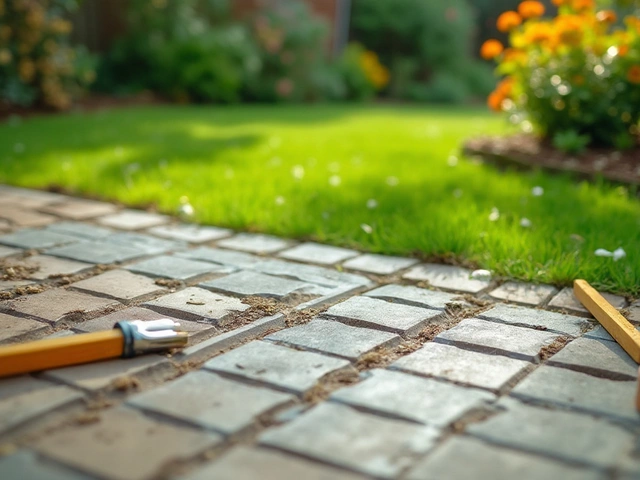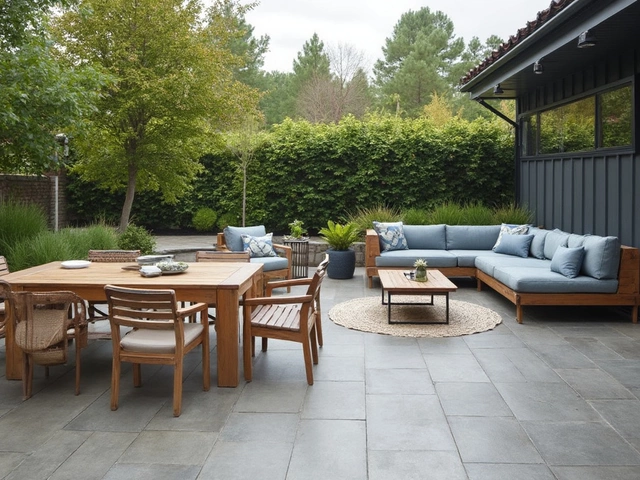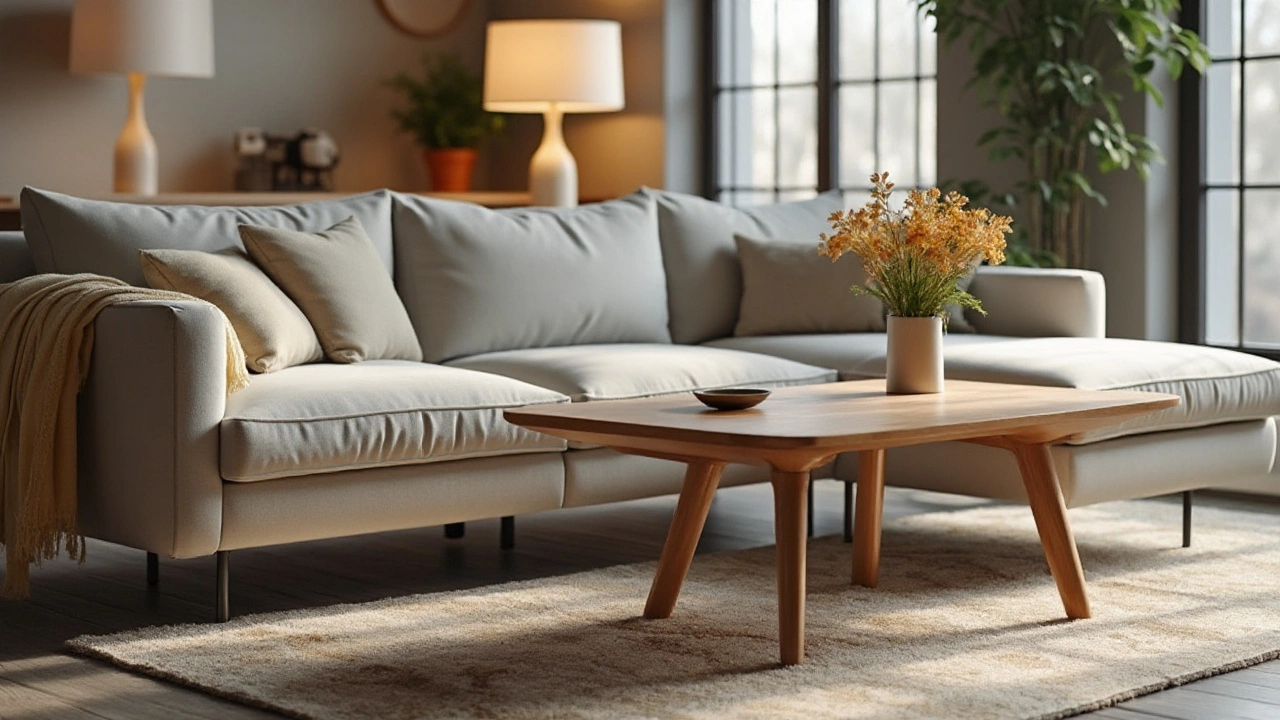
In the world of interior design, harmony isn't just a concept; it's the mantra that guides creating comfortable and aesthetically pleasing spaces. The coffee table and couch are crucial pieces of the living room puzzle, and their dimensions often dictate how cohesive the area appears and functions. A frequent topic within many living rooms is whether the coffee table should be taller than the couch, or if it's preferable to keep it at a lower or equal height.
While some may instinctively argue for symmetry, there's more beneath the surface to consider. From how effortlessly you can reach your cup of joe to how well different styles marry, height does more than impact sight—it influences interaction and usability.
We delve into why one might choose a coffee table that's slightly taller than the couch and explore the potential benefits and drawbacks. Whether aiming for a modern, edgy look or striving for classical elegance, this choice can significantly affect both form and function within your living area.
- Understanding Standard Heights
- The Pros and Cons of Taller Tables
- Designing for Comfort and Style
- Practical Considerations and Tips
- Creative Ways to Achieve Balance
Understanding Standard Heights
When arranging furniture, understanding standard coffee table height in relation to couches is essential. Traditionally, coffee tables tend to be about 16 to 18 inches high. This range is quite accommodating because it matches well with the seating height of most standard sofas. Typically, a couch's seat measures around 17 to 19 inches from the floor to the top of the cushion. This close alignment has long been a guiding principle in achieving a harmonious setup, where accessibility meets aesthetic. The general rule is for the coffee table's height to be the same or slightly lower than the couch's seat, making it easy to reach while sitting.
But why stick to tradition? It's crucial to consider why conventional wisdom favors these dimensions. Harmony in height aids in creating an uninterrupted visual flow in a room, leading the eye smoothly across furnishings rather than causing it to jump because of uneven lines. Then there's practicality: a table at seat height or slightly lower is easier to reach without discomfort, encouraging its use as a central piece for both convenience and relaxation. Interior design expert, Jane McCowan, has noted, "The relationship between the couch and the table in terms of height can affect how people interact with these pieces, from using them for dining or work to simply relaxing."
Despite these norms, some individuals choose taller tables for various reasons. The difference might seem minor, but even those extra two inches can bring a different dynamic to the living room. For homes where couches are especially low—often seen in modern or minimalist designs—a taller coffee table might actually balance the room better by contrasting with the couch, instead of matching it. This can draw attention and add an element of visual interest that a traditional setup might lack.
Benefits of Knowing Height Standards
Having an awareness of standard heights helps when selecting furniture to organically fit your home's style without insisting on what might not naturally complement your existing decor. When considering whether to push the boundaries of these norms, one should evaluate the intended use of the space. If your living room frequently doubles as a workspace or dining area, a taller coffee table might be true gold. In fact, an increased height can transform the table into a more versatile surface.
A 2019 survey showed that almost 40% of people use their coffee tables as makeshift desks, emphasizing the multifaceted roles this piece of furniture can take on in a contemporary lifestyle. Bringing a deeper understanding of these standard heights allows greater flexibility in personal design choices, helping to ensure that both function and form serve the desired purpose. Whether abiding by tradition or straying a bit, understanding the interplay between table and couch heights makes a significant difference in achieving an enjoyable living space.
The Pros and Cons of Taller Tables
Thinking about making your coffee table taller than your couch? It could be a bold choice that offers a range of benefits while presenting a few challenges. A principal advantage is the ease of access it provides. Imagine reaching for your morning brew without having to lean all the way down. This added height can significantly improve comfort, especially for those who use mobility aids or have a family with different age groups. The increased height makes activities like writing or reading much easier, turning your coffee table into more than just a decor piece.
Nevertheless, you should also consider potential downsides. For instance, a taller table could disrupt the aesthetic balance of the room, making your living room furniture seem out of sync. Harmony in furniture height not only enhances visual appeal but also contributes to a sense of order and tranquility in a room. Deviating from this can create an unintended focal point that draws attention away from other design elements, like artwork or a stunning couch.
"A room should never allow the eye to settle in one place. It should smile at you and create fantasy." – Juan Montoya
Another factor to weigh is safety; a table rising above the couch can become a hazard if it's situated in a high-traffic area. Children or pets might bump into it more easily, leading to accidents. Also, pay attention to how this height difference affects seating arrangements during gatherings. While an elevated table can serve as a formal dining setup for appetizers and drinks, it could prove awkward if guests lean over and risk toppling items placed on the table.
For interior design tips, consider the shape and style of both the couch decor and the coffee table. A slender, elegant table may pair better with a plush, low-profile couch, enhancing the room's playfulness and sophistication. Conversely, a more robust table might demand a correspondingly robust seating piece, emphasizing strength and solidity in design. Weigh these pros and cons carefully to see if a taller table fits your lifestyle and aesthetic vision.
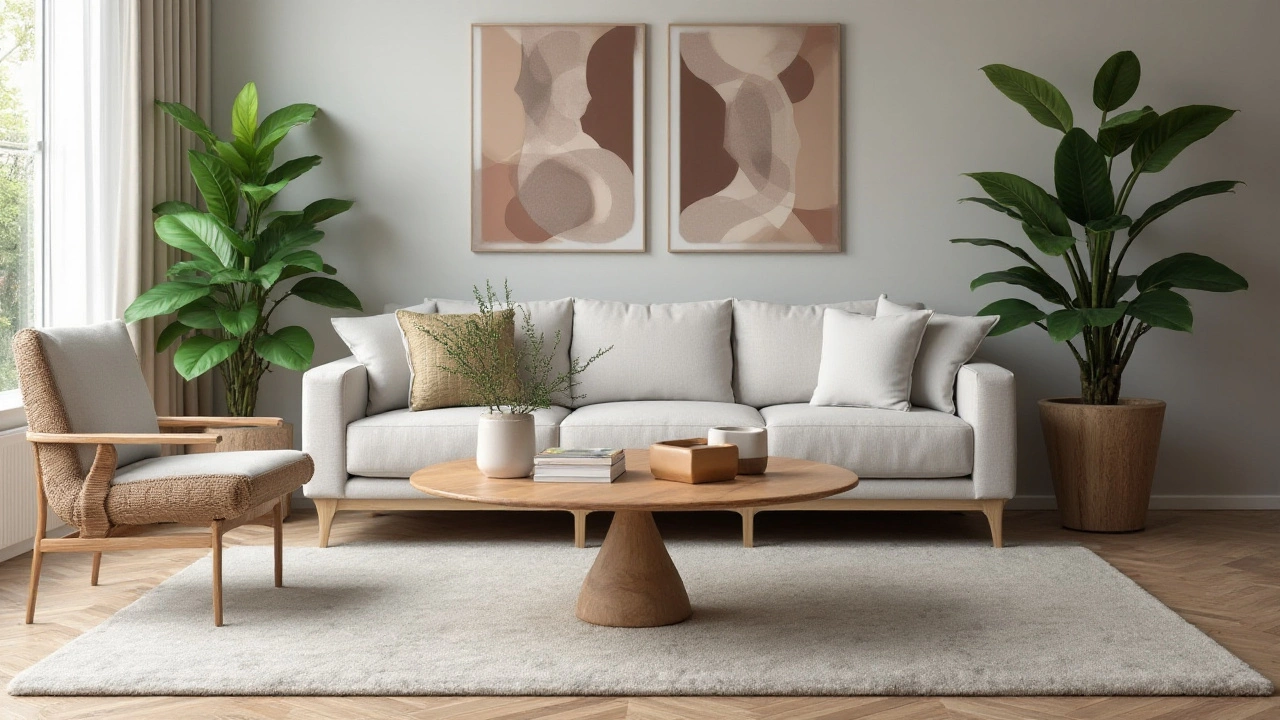
Designing for Comfort and Style
Crafting the ideal living room arrangement involves a delicate balance between style and comfort. The height of your coffee table in relation to your couch can be critical for achieving this balance. You might be pondering if having a coffee table that is two inches higher than your couch could enhance the room's aesthetics or hamper its functionality. To design for comfort, accessibility plays a key role. Having a coffee table slightly taller than your seat can bring your book or coffee cup within easy reach, especially when you’re lounging or seated back on a plush cushion. This small height difference can also provide a sense of easy accessibility when one is entertaining guests, ensuring that your beloved treasures or snacks are conveniently close. One might argue that this taller setup speaks to the needs of our increasingly convenience-oriented lifestyles.
However, aesthetics are not to be compromised for mere convenience. The interplay between your living room furniture pieces suggests a harmony that can be both striking and subtle. Matching or purposefully mismatching heights can create visual interest and depth, attributing to a space that feels intentionally designed. An elevated table might introduce an air of sophistication, drawing the eye and serving as a centerpiece of conversation. It complements modern or minimalist themes, where the differential in heights could offset monotony in lines and planes. Interestingly, flexibility in design allows for a play of materials and shapes – a marble-topped or industrial-style table can add contrast to a soft, upholstered couch, resulting in a contemporary vibe that many strive to capture in their homes today.
Considering Function versus Fashion
Functionality and fashion need not always be at loggerheads. Take, for instance, the coffee table’s role throughout history. It gracefully served as a social hub in living rooms since the Victorian era, acting both as a practical item and a display for one’s tastes and interests. The height factor can subtly affect this role, influencing how items are displayed and accessed. Balancing function and beauty might involve incorporating pieces that offer flexible adjustability. Some modern tables even come with adjustable legs, allowing you to tailor the height to your current needs or whims, bringing about a surprise element of versatility. Interior design tips recommend experimenting with accessories – what lies atop the table can alter its perceived height. Tall vases, stacked books, or tiered trays can add vertical intrigue without physically altering the table's structure, highlighting your holistic approach to design.
"The real purpose of design is to create beauty and functionality in equal measures," says Amanda Gates, a renowned interior designer.
Beyond pure appearance, consider the enticing world of material contrasts. Glass, wood, and metal often feature in a strategic mix, evoking a balance between hard and soft tones, much like a symphony that must include both crescendo and piano dynamics to truly move its audience. A slightly taller coffee table can command presence, and when paired with your couch, it can transform a mundane space into an inviting sanctuary. And while we mustn’t relinquish the factors of comfort and everyday utility, we should remember that such settings, when curated with care, go beyond simple utility – they resonate with one's unique identity.
Practical Considerations and Tips
When it comes to choosing the optimal height for your coffee table in relation to your couch, there are several practical points to mull over. First, comfort is key, which means considering the typical seating posture and reach of those who frequently use the space. Ideally, a coffee table should be at a height that allows people to comfortably reach for their coffee mugs, books, or remotes while sitting back. If a table is too tall or too short, it might create inconvenience and even ergonomic discomfort. A table that's two inches taller than the couch might suit taller individuals or be a delight when using it as a workspace, but it could be a hurdle for others.
Moreover, you should factor in the purpose of your living room. If relaxation and informal gatherings are primary activities, then a taller coffee table could inhibit fluid interaction between guests, acting as a barrier instead of a bridge. A shorter table might encourage a more laid-back vibe where people can easily see and interact with each other. In contrast, a taller table is fitting if functionality, such as dining or working, trumps socialization.
"Design is not just what it looks like and feels like. Design is how it works." - Steve Jobs. This quote rings true when thinking about the balance of height in furniture arrangement. Well-designed spaces are those that don't just focus on aesthetics but usability too.A key tip when deciding on the height is to create a mock-up setup. Stack books or other flat objects on your current table to experiment with different heights and observe the impact on daily activities. Another factor to consider is how often you rearrange the furniture. A static living room might accommodate a slightly taller coffee table if it fits well with other elements, but in a dynamic setup, flexibility is favored, and a table that's too tall can limit options.
There are key aesthetic elements that blend into the practical aspects as well. The materials and design language of the coffee table should harmoniously align with your living room furniture. For example, a sleek metal and glass table might look fantastic two inches taller than a plush, low-profile couch, capitalizing on a modern, minimalist theme. On the flip side, a rustic wood table towering over a contemporary leather sofa might feel imbalanced. A consistent style and theme can help bridge any height disparities that may be present. Additionally, lighter materials can help offset the visual heft of a taller coffee table, preventing it from dominating the room physically or visually.
Finally, consider safety especially if your household includes children or pets. A coffee table that's unusually higher than the expected norm could lead to bumps and bruises if it disrupts the natural flow of the room. It’s crucial to think about the edges and corners too—these tend to protrude at eye or head level for little ones when the table is too high. Furniture designers often suggest rounded corners or protective padding as effective solutions. And remember, your interior design tips should adapt to your lifestyle. Personalization is powerful; don't be afraid to tailor trends to fit the essence of your home and its unique knick-knacks.
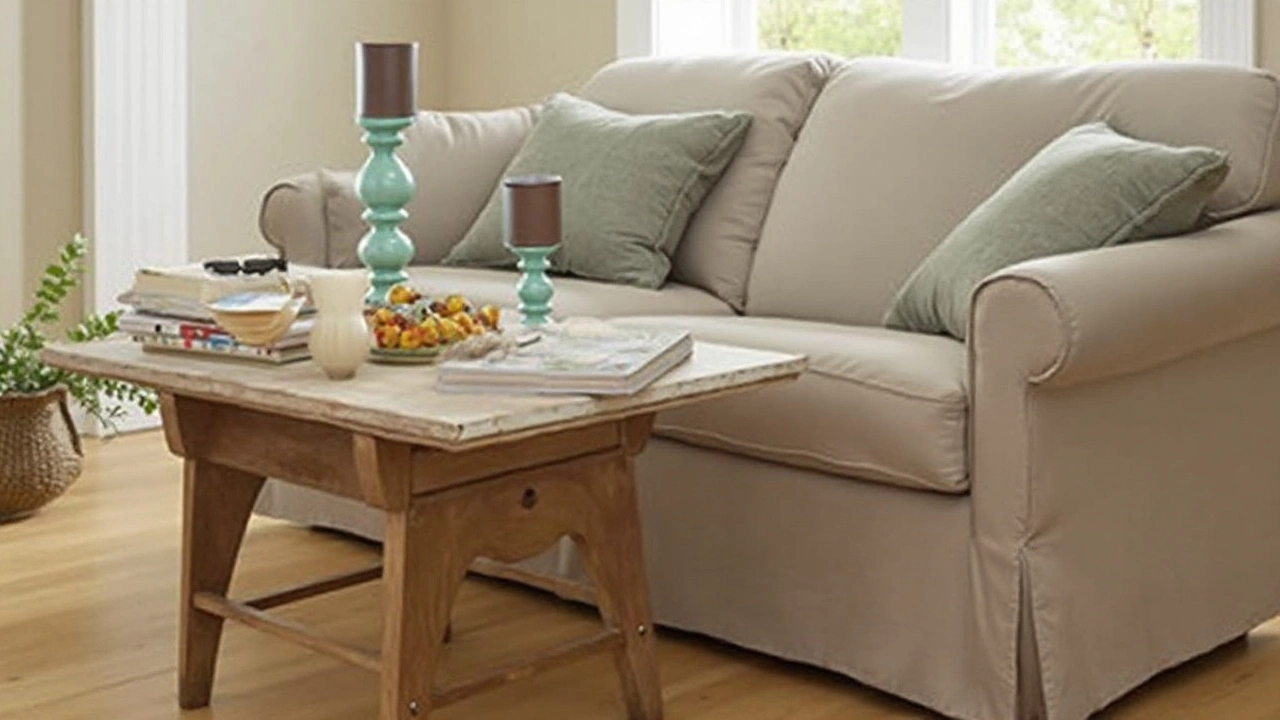
Creative Ways to Achieve Balance
Finding the perfect balance between your coffee table height and your couch is a bit like culinary arts—intimate and exciting yet oh-so-crafty. When your coffee table edges past the couch by those daring two inches, balance is key to ensuring the room doesn't just function but also flourishes aesthetically. One delightful way to strike this balance is by incorporating layered decor elements. Imagine a room where stacks of varied-height books, a slender vase with sprightly blooms, or even a sculpture form a miniature skyline that mirrors your cafe-inspired table. This can detract from any stark height differences, drawing the eye towards texture and form rather than discordance in size.
Incorporating organizational elements can also play a starring role. Trays are not only perfect for corralling the scattered bits and ends of living room life—remote controls, candles, or a collection of coasters—but they bring uniformity to the scene. This touch normalizes differences in table height by creating zones of intended focus. For more tactile richness, play with textiles; introducing runners or cloths draped just-so introduces warmth and softens the lines of the taller coffee table.
Another creative remedy lies within visual tricks and optical illusions. Try anchoring the room with bold area rugs that harmonize the floor space beneath your furniture. This woven bond directly influences how the room perceives height differences. Reflective materials in table surfaces can also assist with perception adjustment. The gleam of a polished surface captures light ingeniously, moderating the visible impact of height when compared to a more matte finish. Clutter-free arrangements bolster this. Embrace the minimalist's mantra where less is tangible space. This concept promotes the seamless integration of a taller table without supposed misalignment distressing the overall rhythm of the room.
"It’s not what you look at that matters, it's what you see." — Henry David Thoreau
Proponents of eclectic design might enjoy integrating asymmetry by leveraging furniture or decor of varying scales. Don't shy away from adding floor cushions, for they don't just offer additional seating but also scale down the coffee-to-table eye-line. Introducing different levels of furnishings, from tall-legged chairs to low-slung seating, creates rhythm and movement that dances around the idea of a uniform center. It’s about inviting the eye on a journey around the room rather than anchoring its gaze on mismatched height.
Lastly, let’s not forget the influence of color and contrast in managing disproportionate heights. Light and bright hues can lift a room, while darker tones add grounded seriousness. If your coffee table is taller, embrace its stature by decorating with lighter top finishes or choosing colors that seamlessly blend with its surroundings. This color cohesiveness can underline the wake of strategic design, quietly correcting dynamics in height through choice of color rather than uniformity of size.

